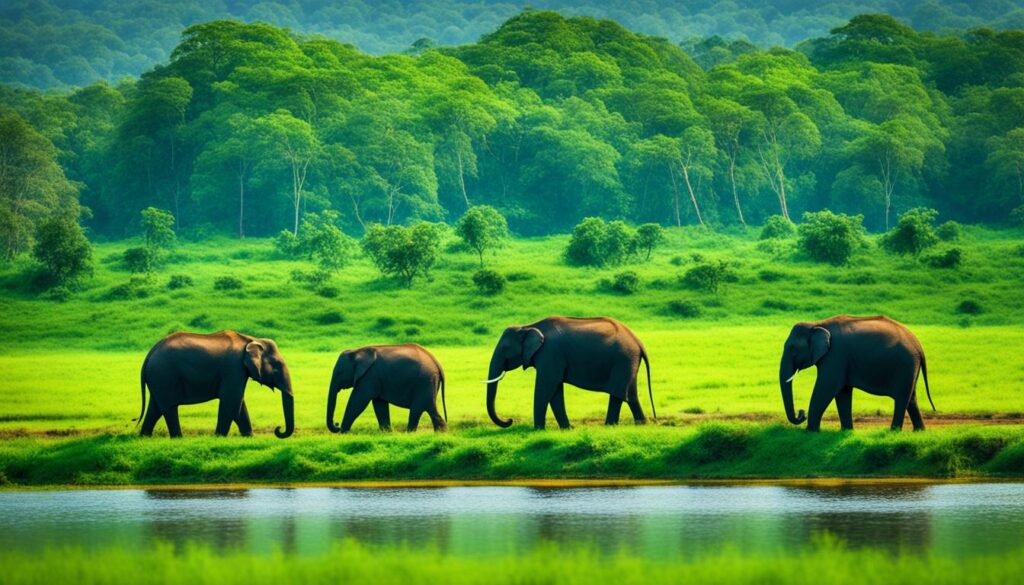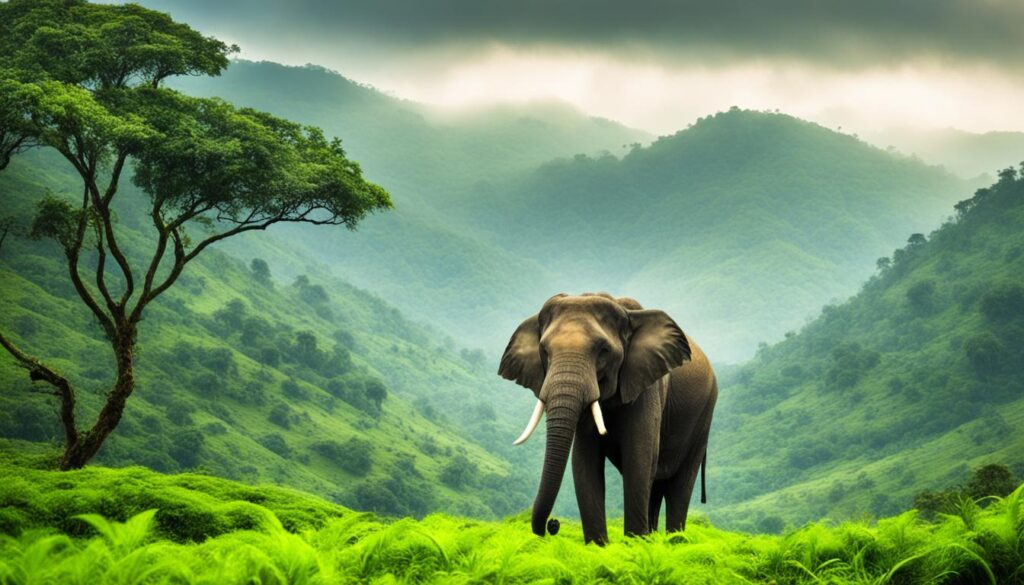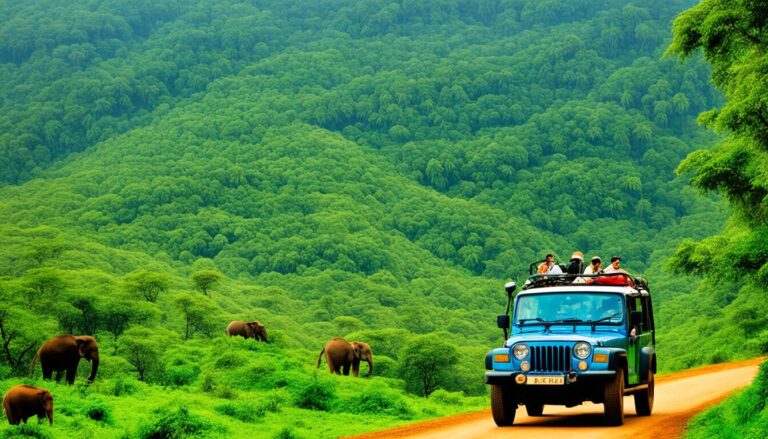Did you know the Western Ghats is home to 325 threatened species? It’s a hotspot for nature lovers, offering a chance to see one of the world’s richest ecosystems. Wildlife tours let you see this amazing diversity up close.
This region stretches across six Indian states, making it a paradise for nature fans. You’ll find everything from lush forests to misty mountains. It’s perfect for those who love nature expeditions, as you can spot rare animals and birds in their natural settings.
But it’s not just about the wildlife. The Western Ghats is also rich in culture and history. You can trek through dense forests or visit ancient temples. Every moment here is an adventure.
Key Takeaways
- The Western Ghats is home to 325 globally threatened species
- It spans across six Indian states
- Wildlife tours offer close encounters with diverse flora and fauna
- The region combines natural beauty with rich cultural heritage
- Various activities available, from trekking to temple visits
Introduction to the Western Ghats’ Rich Biodiversity
The Western Ghats stretch along India’s western coast and are full of life. They are a key spot for those who love nature and want to protect it.
UNESCO World Heritage Site Status
UNESCO made the Western Ghats a World Heritage Site in 2012. This honor shows how important it is to keep this place safe for the future.
Ecological Significance of the Region
The Western Ghats are vital for India’s environment. They help control the weather, manage water, and support many species. Their impact reaches far, affecting the climate and wildlife all over India.
Overview of Flora and Fauna Diversity
The Western Ghats are home to a wide variety of plants and animals. You can find unique animals like the Nilgiri Tahr and Lion-tailed Macaque. Bird lovers will enjoy seeing the Malabar Pied Hornbill and Nilgiri Blue Robin.
From big trees to small insects, the Western Ghats support a unique ecosystem. It’s a place unlike anywhere else on Earth.
“The Western Ghats are older than the Himalayas. They influence Indian monsoon weather patterns by intercepting the rain-laden monsoon winds that sweep in from the south-west during late summer.”
Planning Your Wildlife Tour in Western Ghats
Planning a wildlife tour in the Western Ghats is exciting but requires careful thought. Let’s look at key points to make your trip unforgettable in this rich biodiversity area.
Best Time to Visit
The best time for a wildlife tour is from October to May. This period has nice weather and more wildlife to see. Animals go to water sources in these months, making it easier to spot many species.
Essential Gear and Packing Tips
Having the right gear is key for a great wildlife tour. Here are some tips for traveling in the Western Ghats:
- Binoculars for wildlife viewing
- Comfortable, earth-toned clothing
- Sturdy hiking boots
- Insect repellent and sunscreen
- Reusable water bottle
Choosing the Right Tour Operator
It’s important to pick tour operators with experience in Western Ghats wildlife tours. Look for companies that offer tours tailored to your interests and schedule. Popular routes include Thattekkad-Periyar-Munnar-Kochi and Munnar-Valparai-Mudumalai-Nagarhole.
| Criteria | Importance |
|---|---|
| Local expertise | High |
| Sustainable practices | Essential |
| Customizable tours | Preferred |
| Safety measures | Critical |
By following these tips, you’ll be ready for a memorable wildlife adventure in the Western Ghats.
Top Wildlife Sanctuaries and National Parks
The Western Ghats national parks and wildlife sanctuaries are perfect for exploring India’s rich nature. These places show off the area’s beautiful landscapes and many ecosystems. They are great for those who love nature and wildlife.
Nagarhole National Park
Nagarhole National Park is a treasure in the Western Ghats. It has green forests and lots of animals, like tigers, elephants, and leopards. You can go on exciting safaris or calm boat rides on the Kabini River. These are great for seeing crocodiles and rare birds.

Periyar National Park and Wildlife Sanctuary
Periyar is a top spot in Kerala’s Western Ghats. It’s known for its wide range of wildlife and beautiful views. You can take boat safaris on Periyar Lake to see animals up close, like elephants by the water.
Eravikulam National Park
Eravikulam National Park is in the Munnar hills and is a safe place for the Nilgiri Tahr. It has great trails for hiking and amazing views of the Western Ghats. It also has many unique plants, making it a dream for botanists and photographers.
| Park | Key Species | Best Activity |
|---|---|---|
| Nagarhole | Tigers, Elephants | Jeep Safari |
| Periyar | Elephants, Lion-tailed Macaques | Boat Safari |
| Eravikulam | Nilgiri Tahr, Endemic Plants | Trekking |
Endemic Species of the Western Ghats
The Western Ghats is a hotspot for biodiversity, filled with unique plants and animals. It’s home to many species found nowhere else, making it a dream spot for nature lovers and conservationists.
Some of the most interesting animals here are the Nilgiri Tahr, a goat-like creature, and the Lion-tailed Macaque, known for its long tail. The Nilgiri Langur and Nilgiri Marten are also unique to this area.
Birdwatchers love the Western Ghats for its special birds. The Nilgiri Wood Pigeon and the Kerala Laughingthrush are favorites. The Broad-tailed Grassbird, hidden in high-altitude grasslands, is a rare find.
The plant life is just as diverse and special. Orchids, ferns, and plants with healing properties grow here, making the Western Ghats a key spot for biodiversity.
| Category | Examples of Endemic Species |
|---|---|
| Mammals | Nilgiri Tahr, Lion-tailed Macaque, Nilgiri Langur |
| Birds | Nilgiri Wood Pigeon, Kerala Laughingthrush, Broad-tailed Grassbird |
| Plants | Nepenthes khasiana (pitcher plant), Impatiens johnii (balsam) |
Conservation efforts aim to save these rare and endangered species. Protecting their homes and promoting eco-friendly tourism are key to keeping these unique creatures alive for the future.
Birdwatching Paradise: Avian Diversity in Western Ghats
The Western Ghats is a paradise for bird lovers. It’s home to over 500 bird species. This place lets you see rare and beautiful birds in their natural homes.
Thattekkad Bird Sanctuary
Thattekkad Bird Sanctuary is a dream for birdwatchers. It has 280 bird species, including the Grey Hornbill and White-bellied Tree Pie. The forests here are perfect for watching and photographing birds.
Salim Ali Bird Sanctuary
Dr. Salim Ali Bird Sanctuary is named after a famous bird expert. It’s similar to Thattekkad, with many bird species. You can see the Rufous Babbler here. The area’s varied landscape is great for studying and protecting birds.
Endemic and Threatened Bird Species
The Western Ghats has many birds you won’t find anywhere else. The Nilgiri Flycatcher and Malabar Pied Hornbill are two examples. The White-bellied Blue Flycatcher is also here, but it’s endangered. Seeing these rare birds is a big thrill for birdwatchers.
“The Western Ghats is a living laboratory of evolution, showcasing some of the world’s most fascinating bird species.”
Whether you’re new to birdwatching or an expert, the Western Ghats is amazing. It has different places like dense forests and grasslands. These are perfect for watching and taking pictures of birds in the wild.
Wildlife Tours Western Ghats: Guided Safaris and Nature Walks
Discover the Western Ghats’ rich wildlife through exciting tours. Enjoy thrilling jeep safaris and peaceful nature walks. These tours let you see the area’s natural beauty in new ways.
Jeep Safari Experiences
Start an exciting safari in Nagarhole National Park. Jeep tours bring you close to animals like tigers, elephants, and leopards. Guides share knowledge about the ecosystem, making the tour both fun and educational.
Elephant Rides in National Parks
Try elephant rides for a calm experience. These huge animals let you see wildlife from a new view. You’ll move quietly through forests, seeing animals that hide from loud vehicles.
Guided Nature Trails and Trekking Options
Guided walks show you the Western Ghats’ secret spots. Experts lead you through green forests, showing rare plants and hidden animals. Trails in Eravikulam National Park and the Nilgiri Biosphere Reserve offer stunning views and diverse plants.
Choose from jeep tours, elephant rides, or guided walks for unforgettable experiences. Each option gives a special view of this rich region. You’ll make memories that will stay with you forever.
Conservation Efforts and Sustainable Tourism
The Western Ghats is a hotspot for biodiversity, facing many challenges. Conservation efforts aim to protect endangered species and their homes. Many groups work hard to save this unique ecosystem.
Sustainable tourism is now a key way to help the Western Ghats. Tour operators and places to stay use eco-friendly ways to lessen their impact. This helps both nature and local communities.
Visitors are key to these efforts. By picking responsible tours and following the rules, they help protect this delicate area. Some ways to be eco-friendly include:
- Using reusable water bottles
- Staying on marked trails
- Joining local conservation projects
- Choosing eco-friendly places to stay
Many tours offer special experiences that let you see wildlife and help with conservation. These programs let visitors take part in protecting the Western Ghats while enjoying its beauty.
| Conservation Initiative | Description | Impact |
|---|---|---|
| Reforestation Projects | Planting native tree species | Habitat restoration for wildlife |
| Wildlife Monitoring | Tracking endangered species | Improved conservation strategies |
| Eco-education Programs | Raising awareness among locals and tourists | Increased support for conservation |
By choosing sustainable tourism and eco-friendly actions, we can make sure the Western Ghats’ amazing nature is here for future generations.
Cultural Encounters: Tribal Communities of Western Ghats
The Western Ghats are home to many tribal communities. Each group has its own traditions and a strong bond with the land. Visitors can experience real cultural encounters and learn about traditional life.
Traditional Ecological Knowledge
These tribes have passed down valuable ecological knowledge for generations. They use sustainable farming and manage forests in a way that respects nature. Guests can learn about medicinal plants, wild foods, and old conservation methods from the elders.
Responsible Tourism Initiatives
Responsible tourism in the Western Ghats aims to create deep cultural experiences. It also helps local communities. These efforts include:
- Homestays with tribal families
- Guided tours led by community members
- Workshops on traditional crafts and cuisine
- Participation in cultural festivals and rituals
By taking part in these activities, travelers help protect tribal heritage and support sustainable growth in the area.
| Tribal Community | Cultural Experience | Location |
|---|---|---|
| Toda | Embroidery workshops | Nilgiri Hills |
| Kurumba | Honey harvesting | Silent Valley |
| Irula | Snake conservation programs | Mudumalai |
These cultural experiences let us see the diversity and strength of the Western Ghats’ tribal communities. They also encourage responsible tourism.
Photography Opportunities in Western Ghats
The Western Ghats is a dream spot for nature photographers. It has diverse landscapes and rich wildlife. This means endless chances to take stunning photos.

Best Locations for Wildlife Photography
Nagarhole National Park is a top choice for wildlife photos in the Western Ghats. You can see elephants, tigers, and colorful birds here. Thattekkad Bird Sanctuary is great for bird lovers, with rare and bright birds to photograph. Eravikulam National Park offers stunning landscapes, with hills and misty peaks.
Photography Tips and Techniques
Here are some tips for great nature photos in the Western Ghats:
- Use telephoto lenses for wildlife shots to keep a safe distance
- Shoot in the early morning or late afternoon for the best light
- Bring a sturdy tripod for stability in low light
- Try different angles to get unique shots
- Be patient and respectful of wildlife, letting them come to you
Exploring is key to finding the best photo spots. Consider joining photography tours with expert guides. They can show you hidden gems and help you improve your skills. With these tips, you’ll be ready to capture the beauty of the Western Ghats.
Accommodations: From Eco-lodges to Treehouses
The Western Ghats offer a wide range of places to stay that match the natural beauty. You can choose from eco-lodges to treehouses. This way, you get to enjoy the area’s beauty and have a comfy place to stay.
Eco-lodges in the Western Ghats focus on being kind to the environment. They use solar power, collect rainwater, and build with local materials. Guests can hear nature’s sounds and see wildlife right from their window.
Treehouses give you a special view of the forest canopy. These places let you feel close to nature. You can sleep among the trees and see birds up close.
| Accommodation Type | Features | Location Examples |
|---|---|---|
| Eco-lodges | Solar power, rainwater harvesting, organic gardens | Vythiri, Wayanad |
| Treehouses | Elevated views, unique architecture, nature immersion | Munnar, Thekkady |
| Tea Bungalows | Colonial charm, tea estate tours, mountain views | Sultan’s Battery, Nilgiris |
| Beach Resorts | Seaside location, water activities, coastal cuisine | Marari, Gokarna |
Many places to stay in the Western Ghats offer guided nature walks and chances to see wildlife. You can stay at a tea bungalow in Sultan’s Battery or a nature resort in Vythiri. This is a great way to see the area’s rich nature and local culture.
By picking these eco-friendly places, you help protect the Western Ghats. And you get to have an amazing stay in one of India’s most diverse areas.
Conclusion
The Western Ghats wildlife experience is a journey into India’s most diverse ecosystem. It’s a UNESCO World Heritage Site filled with unique plants and animals. It’s a top spot for nature lovers in India.
Visitors can see rare species, explore green forests, and dive into the area’s rich biodiversity. There are guided safaris and birdwatching adventures for all nature fans. Photographers get many chances to take amazing wildlife photos. Eco-friendly travelers can stay in lodges that help local communities.
The region’s national parks and sanctuaries are key to saving these delicate ecosystems. A visit to the Western Ghats is not just about seeing wildlife. It’s a way to connect with India’s natural heritage and learn about conservation. When planning your trip, know that you’re helping protect these unique places for the future.
